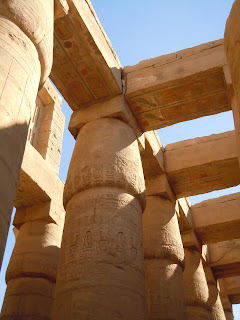January 8, 2012
Friendly Falafel Guy, Luxor
I made a mistake yesterday in following my guidebooks advice
and took a tour of the Valley of the Kings. The place was awesome, but tours
suck. I forked out the ridiculous surcharge to climb into King Tut-ankh-amun’s
TINY tomb. I knew it was going to be less impressive than some of the other
tombs, such as Ramses VI, but come on, it was KING TUT! He did have one cute
wall mural, his mummy, and one of his sarcophagi. To really see the splendor of
Tut you HAVE to check out the Cairo Museum. It’s amazing and well worth the
hype.
beautifully carved gate at Karnak
The guidebooks and plaques refer to this recurring architectural temple element as a hippodrome. I'm not an egyptologist, but hippodromes are for chariots, I'm not quite sure how they'd navigate pillars? Whatever, it's gorgeous!
Renovations continue...
The following day I rented a bicycle and road around the west bank to the Valley of the Queens. As
long as one has some time and it’s not hot this is by far the best (and
cheapest) way to see the sites. Once I got outside the top 3 site groups, I had the Valley of the Nobles to myself! Okay, you can’t entirely escape the hassling tour guides and tomb
guards, just suck it up, cave in and pay out a few cents of baksheesh (the ubiquitous cultural
practice of tipping for everything including wiping your own ass) and the experience
is incredible.
All photos below are of Luxor Temple lit at night.
Above, a mosque has built on top of part of the temple.
Above, is a closeup shot of a Nubian with earrings
and what appears to be facial scars on his cheeks.
I had the good fortune of catching a lecture hosted by the
Mummification Museum. Though open to the public, it’s geared towards
Egyptologists working in the area. Professor Susanne Ostine shared her current
research on the “Life of a Tomb.” Scholarship continues to diversify in
archeology. Rather than concentrating on the big find or a rock star Pharaoh,
this academic is looking at the tomb, holistically. Who and how was the tomb
originally built? Who were the subsequent (dead) occupants (later kingdoms
stopped building tombs and started squatting older tombs)? Her team also
engaged in forensic studies deciphering premortem injuries and diseases from
postmortem vandalism. I could tell from her delivery that she would love to
make a great find, but I also emotionally appreciate that she still carries out the less glamorous and romantic, yet still worthwhile investigations.
Tomorrow topics are Cars and Sex!













No comments:
Post a Comment